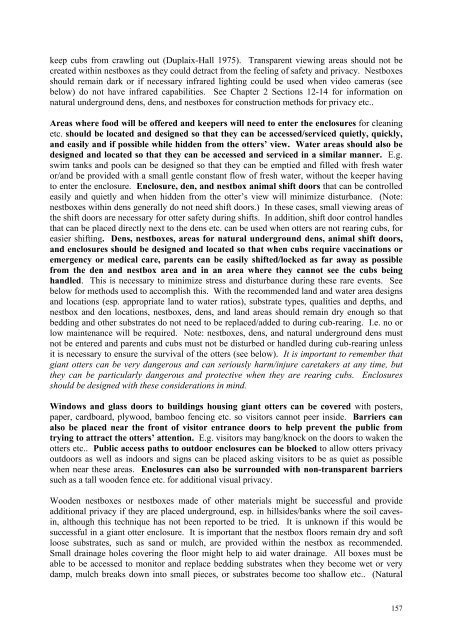International Giant Otter Studbook Husbandry and Management
International Giant Otter Studbook Husbandry and Management
International Giant Otter Studbook Husbandry and Management
Create successful ePaper yourself
Turn your PDF publications into a flip-book with our unique Google optimized e-Paper software.
keep cubs from crawling out (Duplaix-Hall 1975). Transparent viewing areas should not be<br />
created within nestboxes as they could detract from the feeling of safety <strong>and</strong> privacy. Nestboxes<br />
should remain dark or if necessary infrared lighting could be used when video cameras (see<br />
below) do not have infrared capabilities. See Chapter 2 Sections 12-14 for information on<br />
natural underground dens, dens, <strong>and</strong> nestboxes for construction methods for privacy etc..<br />
Areas where food will be offered <strong>and</strong> keepers will need to enter the enclosures for cleaning<br />
etc. should be located <strong>and</strong> designed so that they can be accessed/serviced quietly, quickly,<br />
<strong>and</strong> easily <strong>and</strong> if possible while hidden from the otters’ view. Water areas should also be<br />
designed <strong>and</strong> located so that they can be accessed <strong>and</strong> serviced in a similar manner. E.g.<br />
swim tanks <strong>and</strong> pools can be designed so that they can be emptied <strong>and</strong> filled with fresh water<br />
or/<strong>and</strong> be provided with a small gentle constant flow of fresh water, without the keeper having<br />
to enter the enclosure. Enclosure, den, <strong>and</strong> nestbox animal shift doors that can be controlled<br />
easily <strong>and</strong> quietly <strong>and</strong> when hidden from the otter’s view will minimize disturbance. (Note:<br />
nestboxes within dens generally do not need shift doors.) In these cases, small viewing areas of<br />
the shift doors are necessary for otter safety during shifts. In addition, shift door control h<strong>and</strong>les<br />
that can be placed directly next to the dens etc. can be used when otters are not rearing cubs, for<br />
easier shifting. Dens, nestboxes, areas for natural underground dens, animal shift doors,<br />
<strong>and</strong> enclosures should be designed <strong>and</strong> located so that when cubs require vaccinations or<br />
emergency or medical care, parents can be easily shifted/locked as far away as possible<br />
from the den <strong>and</strong> nestbox area <strong>and</strong> in an area where they cannot see the cubs being<br />
h<strong>and</strong>led. This is necessary to minimize stress <strong>and</strong> disturbance during these rare events. See<br />
below for methods used to accomplish this. With the recommended l<strong>and</strong> <strong>and</strong> water area designs<br />
<strong>and</strong> locations (esp. appropriate l<strong>and</strong> to water ratios), substrate types, qualities <strong>and</strong> depths, <strong>and</strong><br />
nestbox <strong>and</strong> den locations, nestboxes, dens, <strong>and</strong> l<strong>and</strong> areas should remain dry enough so that<br />
bedding <strong>and</strong> other substrates do not need to be replaced/added to during cub-rearing. I.e. no or<br />
low maintenance will be required. Note: nestboxes, dens, <strong>and</strong> natural underground dens must<br />
not be entered <strong>and</strong> parents <strong>and</strong> cubs must not be disturbed or h<strong>and</strong>led during cub-rearing unless<br />
it is necessary to ensure the survival of the otters (see below). It is important to remember that<br />
giant otters can be very dangerous <strong>and</strong> can seriously harm/injure caretakers at any time, but<br />
they can be particularly dangerous <strong>and</strong> protective when they are rearing cubs. Enclosures<br />
should be designed with these considerations in mind.<br />
Windows <strong>and</strong> glass doors to buildings housing giant otters can be covered with posters,<br />
paper, cardboard, plywood, bamboo fencing etc. so visitors cannot peer inside. Barriers can<br />
also be placed near the front of visitor entrance doors to help prevent the public from<br />
trying to attract the otters’ attention. E.g. visitors may bang/knock on the doors to waken the<br />
otters etc.. Public access paths to outdoor enclosures can be blocked to allow otters privacy<br />
outdoors as well as indoors <strong>and</strong> signs can be placed asking visitors to be as quiet as possible<br />
when near these areas. Enclosures can also be surrounded with non-transparent barriers<br />
such as a tall wooden fence etc. for additional visual privacy.<br />
Wooden nestboxes or nestboxes made of other materials might be successful <strong>and</strong> provide<br />
additional privacy if they are placed underground, esp. in hillsides/banks where the soil cavesin,<br />
although this technique has not been reported to be tried. It is unknown if this would be<br />
successful in a giant otter enclosure. It is important that the nestbox floors remain dry <strong>and</strong> soft<br />
loose substrates, such as s<strong>and</strong> or mulch, are provided within the nestbox as recommended.<br />
Small drainage holes covering the floor might help to aid water drainage. All boxes must be<br />
able to be accessed to monitor <strong>and</strong> replace bedding substrates when they become wet or very<br />
damp, mulch breaks down into small pieces, or substrates become too shallow etc.. (Natural<br />
157

















